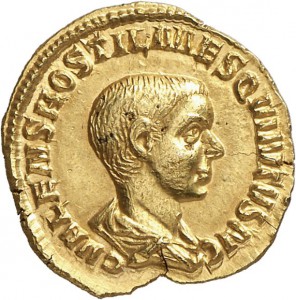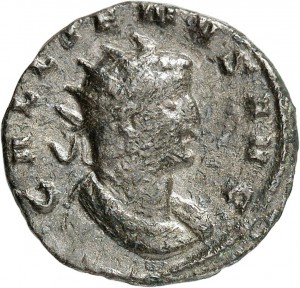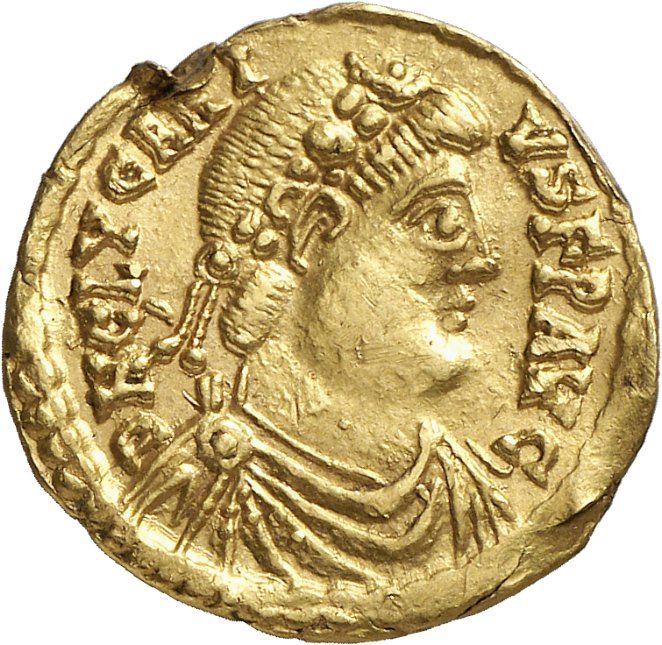On March 9-12, German auction house Gorny & Mosch conducted its biannual auction week. With catalogues featuring a large offer of coins both ancient and modern, the sale offered several collections, including a significant series of Roman Republic coins and a type collection of French coins, starting with the French Revolution.
Record Prices for Roman Gold
A solidus of Glycerius (lot 727) realized 65,000 euros; an aureus of Hostilian (lot 674) realized 50,000 euros; and an aureus of Philip I (lot 669) realized 36,000 euros – evidence that Roman gold is still able to set records, said organizers.

Lot 674, a rare aureus of HOSTILIAN as Caesar (251), graded good Extremely Fine. Estimate: 25,000 euros. Hammer price: 50,000 euros.
“The other results of Gorny & Mosch sale 228 to 230 are nothing to sneeze at, either.”
Auction 228 – Ancient Coins
With an estimate of 12,000 euros, the cover piece of Gorny & Mosch auction 228 was lot 44, a tetradrachm of the Siculo-Punians with attractive toning, superb style and an impressive provenance; the result was equally impressive. The coin changed hands for 24,000 euros.
At half that amount – but still 5,000 euros over the original estimate of 7,000 euros – was a rare gold drachm from Karystos, showing the bearded head of Heracles on the obverse and a lying cow on the reverse.
The various specimens from the series of Athenian coins attracted great interest as well. The “wappenmünzen” brought the highest results in this category: 26,000 euros was the hammer price of a didrachm with the wheel, while the didrachm with the gorgoneion realized 22,000 euros; both were estimated at 10,000 euros.
The first Archaic owl of this series realized 14,000 euros, and 16,000 euros were obtained by the specimen with the attractive helmet’s crest, fully displayed on the planchet, while another tetradrachm, graded Extremely Fine and with the Archaic smile of Athena, brought 12,000 euros.
Also of high numismatic interest was the late Classical tetradrachm with a mint mark showing a bull’s head, which may indicate this coin had been produced in Western Asia Minor or the Levant. It carried an estimate of 2,500 euros but eventually sold for 6,500 euros.

Lot 44, a tetradrachm of SICULO-PUNIANS (320-310), graded about Extremely Fine. Estimate: 12,000 euros. Hammer price: 24,000 euros.
“Coins of the Roman Republic are not as rare,” said organizers, “yet there are always rarities hidden in this category, whose rarity can only be recognized by the connoisseur.”
This was demonstrated by the silver sestertius from the vast series of coins, depicting the head of Apollo on the obverse and a rider pacing on the reverse, struck by L. Calpurnius Piso Frugi around 90 BC. The coin carried an estimate of 2,500 euros, yet the hammer price was 11,000 euros.
“Considering how rare sestertii from this time are, this result is high but still reasonable. When it comes to Roman Republican coins, rarity is perhaps not even as important as beauty,” said organizers, adding that the denarius of C. Publicius from 80 BC, with Hercules strangling the Nemean Lion on the reverse, typically sells at a the three-digit figure.
However, when – like in this case – the specimen is Extremely Fine, fully struck, magnificently centered and with a fabulous patina, then the hammer price will jump significantly. A similar situation happened with a denarius of Papius with the jumping griffin.
“It owed its result, 1,600 euros, entirely to its beauty,” said organizers.
Other highlights of Roman and Byzantine gold coins include: Tiberius in Brilliant Uncirculated, with an estimate of 5,000 euros and hammer price of 13,000 euros; Lucius Verus in Brilliant Uncirculated, with an estimate of 10,000 euros and hammer price of 30,000 euros; Caracalla in Extremely Fine, with an estimate of 5,000 euros and hammer price of 19,000 euros; Philippus Arabs in Extremely Fine, with an estimate of 25,000 euros and hammer price of 36,000 euros; Hostilian in good Extremely Fine, with an estimate of 25,000 euros and hammer price of 50,000 euros; Glycerius in about Extremely Fine, with an estimate of 30,000 euros and hammer price of 65,000 euros; and lastly, Michael II in good Extremely Fine, with an estimate of 14,000 euros and hammer price of 22,000 euros.
Auction 229 – Ancient Coins and Multiple Lots
“It’s tradition that the second day of each Gorny & Mosch auction is devoted to the coins that are intended for collectors who have to keep an eye on their budget,” said organizers. “Yet everybody knows that there is also much material available that’s of interest to keen special collectors.”
Lot 199, the rare drachm of the Armenian ruler Artavasdes III, featuring the portraits of himself and the Roman emperor Augustus, sold for 18,000 euros.

Lot 199, a rare drachm of ARTAVASDES III (5-2 BC) or Artavasdes IV (AD 4-6), graded Very Fine. Organizers said this is probably the only specimen in private possession. Estimate: 17,000 euros. Hammer price: 18,000 euros.
And for collectors of Armenia, there were 15 Armenian coins with prices ranging from 120 to 800 euros. The total estimate of 2,750 euros was markedly exceeded by the hammer price of 5,410 euros.
“Admittedly,” said organizers, “that’s not as spectacular as the prices the Roman gold obtained, but that surely did not dampen the joy the proud new owners experienced.”
And those interested in pieces from the 3rd century AD were excited to find these: a legionary coin of Gallienus, with the wild boar on the reverse, which carried an estimate of 120 euros but realized 700 euros, and a quinarius of Probus on his victory over the Germans realizing 2,000 euros on a pre-sale estimate of 1,500 euros.
Auction 230 – Medieval and Modern Times/ France and Colonies/Russia
With a total estimate of 570,000 euros, auction 230 eventually realized 875,000 euros.
Organizers said the offer included many exciting but reasonably estimated specimens, which was appreciated by a great number of customers.
“The many mining thaler found an audience that was interested and eager to bid.”
All items were sold, with most items surpassing their estimates.
Highlights include lot 3085, the mining thaler 1684 HB of Ernest Augustus of Brunswick-Calenberg (with an estimate of 1,200 euros and hammer price of 4,600 euros); the mining thaler 1720 HCB of George I Louis of Brunswick (with an estimate of 750 euros and hammer price of 2,400 euros); and the mining medal 1847 of Frederick Augustus II of Saxony on the yields of the Himmelfahrt samt Abraham zu Freiberg Mine (with an estimate of 1,000 euros and a hammer price of 2,600 euros.
“It’s, of course, always interesting to see how unerringly collectors pick out the really rare pieces,” said organizers.
An extremely rare half-vereinsthaler, issued by Louis IV of Marburg in 1572, rose from its estimate of 500 euros to 3,600 euros. An unsigned Silesian patenpfennig from 1704 started at 350 euros to arrive at 1,800 euros in the end.
“In the light of the artistic skills deployed in the production of the 16th century German medals,” said organizers, “the estimates of the ones on offer, under lots 3342 to 3349, have actually been a bit too modest, although the prices they obtained were not that bad.”
The coins and medals from medieval and modern times were highlighted by a type collection of French coins, starting with the French Revolution, with numerous medals and another series of coins from the French colonies.
“Let’s not look for record prices there,” said organizers. “It’s enough to know that there are so many collectors in Germany interested in that field that just 16 lots were left unsold out of the total number of almost 200.”
With a total estimate of 45,000 euros, auction 230 realized 67,000 euros – an impressive result, said organizers.
The big surprise was a bronze medal with the portrait of William II of Montferrat (1494-1518), which started at 100 euros but realized 2,400 euros in the end.
Almost as big was another medal, from 1580, bearing the coat of arms of William Scheuhenstuel of Weyching and his wife Frau Lucia Zandegger. It had likewise carried an estimate of 100 euros but was auctioned off for 2,000 euros.
Lot 3925, with the estimate for the 118 items in all possible grades at 50 euros, topped out at 1,000 euros.
“Apparently,” said organizers, “two connoisseurs had discovered a big rarity there.”
Next in line were the Islamic coins with a collection of Ottoman specimens.
“Numerous rarities were offered for sale and the customers clearly appreciated these.”
A Very Fine altin of Selim I from 1517, Misr Mint, realized 4,200 euros after an estimate of 1,000 euros.
A rare Zinyet coinage, following the Istanbul model and struck in the Misr Mint, triggered a fierce bidding war and changed hands along with 10,000 euros after an estimate of 1,000 euros.
Concluding the sale was an impressive collection of Russian coins.
Organizers said the prices realized are a testament to the significantly diminished ruble, which has dropped in value against the euro.
“The coins and medals in the low- and mid-range price segment have lost a number of buyers to the effect that the Russian coins and medals are relatively advantageously priced at the moment. When was the last time a bronze medal with the portrait of Peter I on the Battle of Poltava, graded Extremely Fine to Brilliant Uncirculated, was available for mere 300 euros?”
Highlights include a ruble 1889 AG struck in the St. Petersburg Mint, graded Brilliant Uncirculated, that rose from 7,500 euros to 26,000 euros. The big rarities – like the Order of the White Eagle, for instance – didn’t reach their estimate. Some were even left unsold, like the silver 5 kopeck piece 1860 SPB-FB from St. Petersburg.
All auction results can be viewed online at gmcoinart.de/ergebnislisten. For auction 228, click here; for auction 229, click here; and for auction 230, click here.
The next auction, of ancient art, is scheduled for June 17. The next coin auction will be conducted between October 5-9. Consignments for the latter are welcomed until July 28. To consign a collection, contact Gorny & Mosch, Giessener Münzhandlung, Maximiliansplatz 20, D-80333 Munich, phone +49 / (0)89 / 24 22 643-0, telefax +49 / (0)89 / 22 85 513.

